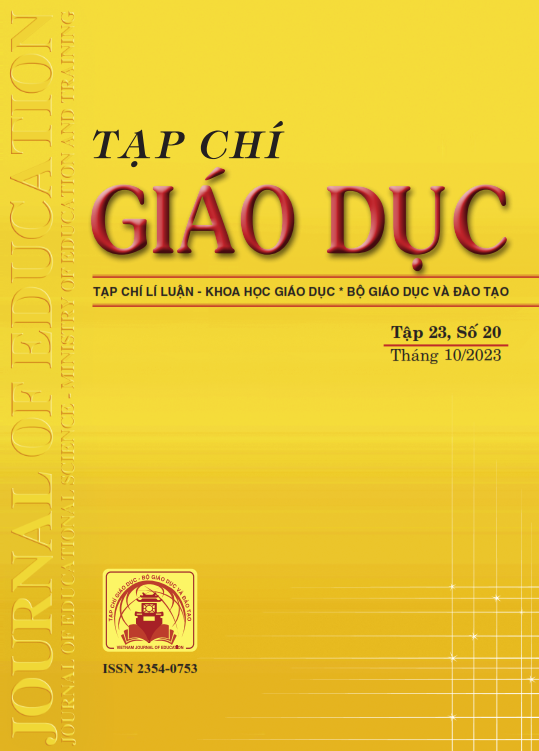Vận dụng tiến trình tư duy thiết kế vào dạy học nội dung “Làm đồ chơi” (Công nghệ 3) theo định hướng giáo dục STEAM
Tóm tắt
The STEAM education model has been widely applied at many educational levels and countries around the world. In Vietnam, this educational model is being encouraged to be applied at the elementary level to meet the requirements of the 2018 General Education Program. This research study introduces the design thinking process in teaching the Technology subject in grade 3 following STEAM education approach and applies this process to teaching the content “Making toys” (Technology 3). The teaching practice shows that applying the design thinking process to teaching Technology in elementary schools is appropriate. During the process of participating in the learning activities organized by teachers, students have the opportunity to apply the learnt knowledge and skills as well as their own experience to have a comprehensive perspective on the problem and gain understanding and sympathy with friends and surrounding people, be active in the learning process, proactively design ideas and select implementation solutions.
Tài liệu tham khảo
Aflatoony, L., Wakkary, R., & Neustaedter, C. (2018). Becoming a design thinker: assessing the learning process of students in a secondary level design thinking course. International Journal of Art & Design Education, 37(3), 438-453. https://doi.org/10.1111/jade.12139
Bộ GD-ĐT (2018). Chương trình giáo dục phổ thông môn Công nghệ (ban hành kèm theo Thông tư số 32/2018/TT-BGDĐT ngày 26/12/2018 của Bộ trưởng Bộ GD-ĐT).
Dell'Era, C., Magistretti, S., Cautela, C., Verganti, R., & Zurlo, F. (2020). Four kinds of design thinking: From ideating to making, engaging, and criticizing. Creativity and Innovation Management, 29(2), 324-344. https://doi.org/10.1111/caim.12353
Henriksen, D., Mehta, R., & Mehta, S. (2019). Design thinking gives STEAM to teaching: A framework that breaks disciplinary boundaries. In S. A. Myint Swe Khine (Ed.). STEAM education: Theory and practice (pp. 57-78). Springer International Publishing. https://doi.org/10.1007/978-3-030-04003-1_4
Herro, D., Quigley, C., Andrews, J., & Delacruz, G. (2017). Co-Measure: developing an assessment for student collaboration in STEAM activities. International Journal of STEM Education, 4, 26-32. https://doi.org/10.1186/s40594-017-0094-z
Li, J., Luo, H., Zhao, L., Zhu, M., Ma, L., & Liao, X. (2022). Promoting STEAM education in primary school through cooperative teaching: A design-based research study. Sustainability, 14(16), 1-16. https://doi.org/10.3390/
su141610333
Martin, R. (2010). Design thinking: achieving insights via the “knowledge funnel”. Strategy & Leadership, 38(2), 37-41. https://doi.org/10.1108/10878571011029046
Tạ Thanh Trung, Tạ Hoàng Anh Khoa, Nguyễn Thanh Nga (2023). Năng lực tư duy thiết kế của học sinh thể hiện qua bài học chủ đề STEAM định hướng giải quyết vấn đề bằng sự đồng cảm. Tạp chí Khoa học và Công nghệ, Đại học Thái Nguyên, 228(04), 165-173.
Timotheou, S., & Ioannou, A. (2021). Collective creativity in STEAM Making activities. The Journal of Educational Research, 114(2), 130-138. https://doi.org/10.1080/00220671.2021.1873721
Tschimmel, K., & Santos, J. (2019). Design Thinking Applied in Higher Education. In Education Applications & Developments IV Advances in Education and Educational Trends Series Edited by: Mafalda Carmo (pp. 259-311).
Watson, A. D. (2015). Design thinking for life. Art Education, 68(3), 12-18. https://doi.org/10.1080/00043125.2015.11519317
Yakman, G. (2008). STEAM education: An overview of creation a model of integrative education.
Tải xuống
Đã Xuất bản
Cách trích dẫn
Số
Chuyên mục
Giấy phép

Tác phẩm này được cấp phép theo Ghi nhận tác giả của Creative Commons Giấy phép quốc tế 4.0 .












